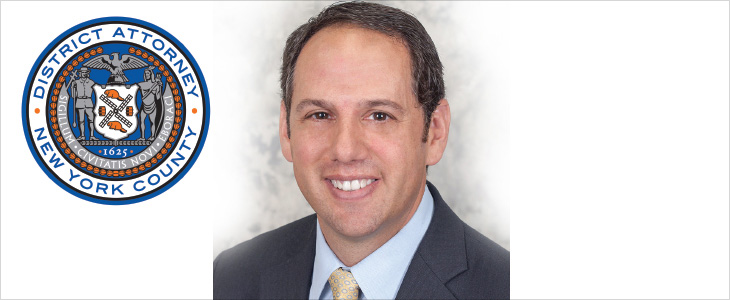
ACAMS Today spoke with David Szuchman, executive assistant district attorney and chief of the Investigation Division of the New York County District Attorney’s office to discuss cybercrime, fraud and identity theft.
Szuchman began his legal career at the Manhattan District Attorney’s Office in 1997 as an assistant district attorney in Trial Bureau 40. Szuchman later became a trial attorney in the criminal division of the U.S. Justice Department, assigned to the Child Exploitation and Obscenity Section and then worked as an assistant attorney general in the New York Attorney General’s Office on complex fraud and anti-trust cases. In 2009, Szuchman was appointed as the director of the New Jersey Division of Consumer Affairs. This department enforced laws and regulations designed to protect New Jersey’s residents in the marketplace, including securities regulation and mortgage fraud enforcement. Szuchman was also responsible for internet safety initiatives on behalf of former New Jersey Attorney General Anne Milgram.
He rejoined the office in 2010 as chief of the Cybercrime and Identity Theft Bureau. The Bureau is tasked with prosecuting all types of cybercrime, ranging from cyber stalking and child pornography cases to computer intrusions and malware. In addition, the Bureau handles over 200 identity theft cases per month. In April 2012, Szuchman was appointed deputy chief of the Investigations Division. In this position, he assisted Division Chief Adam Kaufmann in developing policies and investigative strategies, maintaining relationships with outside agencies, and helping to supervise investigations throughout the Division. He was appointed executive assistant district attorney and chief of the Investigation Division on November 15, 2012. Szuchman graduated from the University of Vermont in 1994 with a bachelor’s degree in political science, and received a law degree in 1997 from Hofstra University School of Law.
ACAMS Today: How can financial institutions assist law enforcement in cracking down on all types of fraud?
David Szuchman: First and foremost, financial institutions should maintain an open dialogue with law enforcement. We’re not necessarily seeking criminal referrals, but it is critical for the protection of consumers and the industry as a whole that there are criminal consequences for fraud. Otherwise, the perpetrator is emboldened to commit additional crimes in the future. We encourage all industries to report fraud to law enforcement. Groups like the international, not-for-profit Global Cyber Alliance, which share information about threats and intrusions across sectors, and are critical to combating fraud.
AT: How has the explosion of mobile technology in the last decade affected cybercrime investigations?
DS: The impact has been huge. Cybercriminals are no longer hiding behind a computer or laptop in a house anymore—everybody is on the street, using handheld, mobile devices and apps to commit crimes. Law enforcement has had to adapt to the changing face of cybercrime by deploying different techniques and tools to keep pace with ever-changing technology.
AT: What is the most surprising cybercrime case you have come across?
DS: I’ve been in this field long enough that few things surprise me anymore. That being said, in the Manhattan DA’s Office, we frequently come across local actors affiliated with traditional street gangs in New York City buying personal identifiable information from hackers in places like Ukraine. This breaking down of international borders has been a major, if not surprising, transformation in the way cybercrime and cyber fraud is committed.
AT: Which type of crime is the most challenging to prosecute and why?
DS: In terms of investigations, any type of money movement is challenging to prosecute because the flow of money often takes place outside of the U.S., and we lose visibility as to where the money is going and how it’s being transacted. It can be especially difficult to follow the money in places where we lack the ability to quickly gain access to records or freeze proceeds. Personally, child abuse and child exploitation cases have been some of the most challenging for me to prosecute, for all the obvious reasons. It’s difficult and important work, but I also consider them the most gratifying that I will ever prosecute.
AT: How can financial institutions and individuals protect themselves from identity theft, hackings and other types of fraud?
DS: The easiest way for financial institutions to protect themselves is to share information about threats or attacks with law enforcement. This is why DA Vance made a $25 million investment last year in the Global Cyber Alliance, with our partners at the City of London Police and the Center for Internet Security. The group has pledged to not collect any personal identifiable information, and works with voluntarily provided data to describe or identify the attackers’ information, not the victim’s, and any associated threats. Members include leaders from security, defense, retail, healthcare, insurance, energy, aviation, education, law enforcement, government, and finance institutions, and the list is growing by the day.
For individuals, it is important to remain vigilant. All those tips you read about frequently monitoring your bank and credit card accounts should be followed. Be wary of phishing emails, know how to recognize them, and most importantly, do not click on them. All of those warnings that everyone has become mute to need to be followed to avoid having malware introduced on your device and compromising your personal information. Once it is compromised in one place, the fraud is easily multiplied across accounts, credit cards, and the like.
AT: If you are a victim of a cybercrime, what are the next crucial steps?
DS: Check your credit reports regularly and report any suspicious activity to financial institutions, credit monitoring services and law enforcement. Financial institutions are great at reimbursing customers who fall prey to identity thieves, but it is critical to not let the data associated with your compromise end with the bank or financial institution. Law enforcement needs to know about it so we can tease out patterns across multiple institutions, prevent future cybercrimes and ideally hold the criminals accountable.
AT: Can you share some lessons learned from recent identity theft cases?
DS: There is no single profile for an identity theft criminal. It’s being done in so many different ways today. Criminals are taking advantage of loopholes in the banking system, or taking advantage of unsuspecting victims. The lessons learned are, unfortunately, that you can’t let your guard down for a minute without exposing yourself to some degree of risk.
AT: How are terrorists leveraging technology to fund their terrorist attacks?
DS: We’re not really seeing crowdsourcing; what we’re seeing is terrorists advising others to use technology, especially encrypted apps, as a way to communicate with associates about the need for funding. Notably, most of the terrorist attacks you read about are being executed with relatively little funding. Huge dollar amounts aren’t needed to commit many of these attacks perpetrated by homegrown, violent extremists.
AT: What challenges will law enforcement face when investigating cybercrime in the next five years?
DS: A significant challenge we’re facing right now is default device encryption, which Apple introduced in September 2014 before Google quickly followed suit. Apple’s iOS and Google’s Android run 96.7 percent of smartphones worldwide, meaning the criminal evidence on this universe of devices is currently inaccessible to investigators, despite lawful, judicial warrants to search them. Smartphone makers offered strong encryption without any documented security problems before September 2014, but have never explained why the switch to default encryption was necessary. This is not a problem that is unique to my office—it’s shared by federal and state prosecutors and police departments around the country, and I can only hope that we find some kind of resolution in five years.










